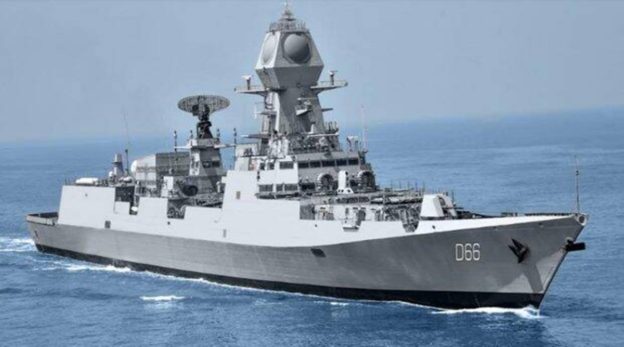Indigenous developments, in the case of weapon and sensor systems in the Indian Navy, are being undertaken through ab-initio design and development route is the call of the day in the current geopolitical situation.
With the restricted availability of critical weapons and sensor spares from Russia and denial of license to import critical components from other western countries, greater thrust is now being given to indigenisation of critical systems of the Indian armed forces.
Indigenous developments, in the case of weapon and sensor systems in the Indian Navy, are being undertaken through ab-initio design and development route is the call of the day in the current geopolitical situation. ‘Self-reliance’, ‘indigenisation’ and ‘Make in India’ have been the mantra of the Indian Navy for over five decades. Additionally to this list is “Innovation” to leapfrog in technology.
Keeping in line with Prime Minister Narendra Modi’s Atamnirbhar Bharat and industrial development (Make in India) initiatives, the Indian Navy has been at the forefront of indigenisation with a fully functional and dynamic Directorate of Indigenisation. Additionally, a Technology Development Acceleration Cell (TDAC) has been created under Naval Innovation and Indigenisation Organisation (NIIO) to focus on innovation.
The Navy as a customer, the designers of equipment & systems and the industry as a supplier has a clear understanding of the requirements and the plan for induction and indigenisation.
History of Indian Navy’s Indigenisation Journey
The commitment for self-reliance in the Indian Navy (IN) came to the fore as early as 1961 with the commissioning of the first indigenous ship INS Ajay. Subsequently from the mid-’60s Navy embarked on the construction of the indigenously built Leander class Frigates on Transfer of Technology (ToT) from the Royal Navy.
NIIO & NTAC
The NIIO and Naval Technology Acceleration Council is a pragmatic initiative. Earlier this week, Naval Technology Acceleration Council (NTAC) the apex body of NIIO held its 2nd meeting in which the ongoing and proposed innovation and proposed indigenisation cases were reviewed. The meeting was chaired by VAdm SN Ghormade, Vice Chief of Naval Staff.
In an official statement issued by the Ministry of Defence (MoD), every month since the launch of the NIIO in 2020, on an average more than two IPR applications have been filed by naval personnel.
Patent applications have been filed for military-specific as well as dual-use innovations and through the National Research & Development Corporation (NRDC) and the Rashtriya Raksha University many dual-use products have also already been transferred to the MSMEs for bulk production.
Also, major initiatives towards Indigenisation include industry outreach which is conducted in different locations like — Coimbatore, Ahmedabad and Bhubaneswar.
The involvement of academia within the dialogue and engagement with policymakers, the Indian Navy, and the local industry would help in distinctive policies and boost development of 4IR technologies, platforms and devices under the Atmanirbhar Bharat initiative. An MoU for knowledge partnership has been signed between the Society for Indigenous Defence Manufacturing (SIDM) and Bharat Shakti.in.
There is a burgeoning start-up and innovation culture, as shown by the Global Innovation Index, where India has improved its ranking from 81 to 52 between 2015 and 2019. To maintain this momentum, India must work on improving government regulations to encourage support for technological innovation, train tech talent and incentivize it to remain within the country. The Indian Navy has started the Indian Naval Students Technical Engagement Programme (IN-STEP) which provides a five-month online internship to work on the navy’s current issues.
“Undoubtedly, innovation, economics, a self-reliant and strong military industry are intertwined. NIIO through Technology Development Acceleration cell has been inducting emerging disruptive technology in an accelerated time frame. A balanced modernisation strategy requires both disruptive and capability-based incremental innovations to supply defence capabilities in different time horizons,” explained a senior officer who wished to remain anonymous.
Adding, “While mature technologies solutions act as enablers in the near term, a mix of mature and a few future disruptive technologies, nearing full maturation, will address emerging threats in the medium term.”
In the long term, matured disruptive technologies will create a new paradigm in which the level of performance would exceed the limits of traditional conventional evolutionary innovations and will also radically enhance the performance of existing products.
What is being pursued by TDAC?
Military applications of emerging from the emerging disruptive technology, which is being pursued by TDAC, are cutting edge Science and Technology, which include robotics and autonomous unmanned system, hypersonic, new undersea systems, AI, nanotechnology, EW, stealth meta materials, information and large data analytics, cognitive neurosciences, quantum technology, additive manufacturing, 3D printing, energy and propulsion, directed energy weapon, and cyber capabilities. According to the officer quoted above, “The danger to our military modernisation, in the long run, is the very low fiscal and national commitment on R&D in these cutting edge disruptive technologies”.
In addition to channelling in-house naval innovations, TDAC engages with the academia and the industry and an online monthly interaction with the industry in coordination with the Society of Indian Defence Manufacturers (SIDM) have also been instituted.
Deep tech startups also are being recognised as ‘lnnovation Industry Partners’ and are provided to better understand naval requirements.
But, the latest decision taken in DAC held on 22 Mar 2022 approved “affecting” certain policy initiatives in the Defence Acquisition Procedure-2020 to accelerate the pace of indigenisation, achieve self-reliance in defence and facilitate the ease of doing business for the defence industry.
One of the policy initiatives “effected” on Tuesday was that modernisation requirements of defence forces are going to be indigenously sourced and imports are going to be resorted to only as an exception. Further, another policy initiative affected in the Defence Acquisition Procedure-2020 was that the vendors whose products are successfully trial evaluated will be provided a certificate to that effect. As per the given mandate of TDAC, it has all the potential to become an indigenous version of the US-based ‘DARPA’.
https://www.financialexpress.com/defence/indian-navy-on-track-in-its-self-reliance-journey-focus-now-on-technological-innovations/2471085/





